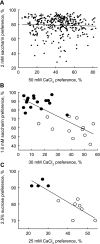Involvement of T1R3 in calcium-magnesium taste
- PMID: 18593862
- PMCID: PMC2519964
- DOI: 10.1152/physiolgenomics.90200.2008
Involvement of T1R3 in calcium-magnesium taste
Abstract
Calcium and magnesium are essential for survival but it is unknown how animals detect and consume enough of these minerals to meet their needs. To investigate this, we exploited the PWK/PhJ (PWK) strain of mice, which, in contrast to the C57BL/6J (B6) and other inbred strains, displays strong preferences for calcium solutions. We found that the PWK strain also has strong preferences for MgCl2 and saccharin solutions but not representative salty, sour, bitter, or umami taste compounds. A genome scan of B6 x PWK F2 mice linked a component of the strain difference in calcium and magnesium preference to distal chromosome 4. The taste receptor gene, Tas1r3, was implicated by studies with 129.B6ByJ-Tas1r3 congenic and Tas1r3 knockout mice. Most notably, calcium and magnesium solutions that were avoided by wild-type B6 mice were preferred (relative to water) by B6 mice null for the Tas1r3 gene. Oral calcium elicited less electrophysiological activity in the chorda tympani nerve of Tas1r3 knockout than wild-type mice. Comparison of the sequence of Tas1r3 with calcium and saccharin preferences in inbred mouse strains found 1) an inverse correlation between calcium and saccharin preference scores across primarily domesticus strains, which was associated with an I60T substitution in T1R3, and 2) a V689A substitution in T1R3 that was unique to the PWK strain and thus may be responsible for its strong calcium and magnesium preference. Our results imply that, in addition to its established roles in the detection of sweet and umami compounds, T1R3 functions as a gustatory calcium-magnesium receptor.
Figures






Similar articles
-
Allelic variation of the Tas1r3 taste receptor gene selectively affects behavioral and neural taste responses to sweeteners in the F2 hybrids between C57BL/6ByJ and 129P3/J mice.J Neurosci. 2004 Mar 3;24(9):2296-303. doi: 10.1523/JNEUROSCI.4439-03.2004. J Neurosci. 2004. PMID: 14999080 Free PMC article.
-
Allelic variation of the Tas1r3 taste receptor gene selectively affects taste responses to sweeteners: evidence from 129.B6-Tas1r3 congenic mice.Physiol Genomics. 2007 Dec 19;32(1):82-94. doi: 10.1152/physiolgenomics.00161.2007. Epub 2007 Oct 2. Physiol Genomics. 2007. PMID: 17911381 Free PMC article.
-
Variation in the gene Tas1r3 reveals complex temporal properties of mouse brainstem taste responses to sweeteners.Am J Physiol Regul Integr Comp Physiol. 2021 Nov 1;321(5):R751-R767. doi: 10.1152/ajpregu.00001.2021. Epub 2021 Sep 15. Am J Physiol Regul Integr Comp Physiol. 2021. PMID: 34523351 Free PMC article.
-
Chorda tympani responses in two inbred strains of mice with different taste preferences.Physiol Behav. 1999 Aug;67(2):287-97. doi: 10.1016/s0031-9384(99)00071-2. Physiol Behav. 1999. PMID: 10477061 Review.
-
Taste information derived from T1R-expressing taste cells in mice.Biochem J. 2016 Mar 1;473(5):525-36. doi: 10.1042/BJ20151015. Biochem J. 2016. PMID: 26912569 Review.
Cited by
-
Genetics of taste and smell: poisons and pleasures.Prog Mol Biol Transl Sci. 2010;94:213-40. doi: 10.1016/B978-0-12-375003-7.00008-X. Prog Mol Biol Transl Sci. 2010. PMID: 21036327 Free PMC article. Review.
-
Influence of cross-fostering on preference for calcium chloride in C57BL/6J and PWK/PhJ mice.Physiol Behav. 2013 Oct 2;122:159-62. doi: 10.1016/j.physbeh.2013.09.002. Epub 2013 Sep 13. Physiol Behav. 2013. PMID: 24041724 Free PMC article.
-
The Different Facets of Extracellular Calcium Sensors: Old and New Concepts in Calcium-Sensing Receptor Signalling and Pharmacology.Int J Mol Sci. 2018 Mar 27;19(4):999. doi: 10.3390/ijms19040999. Int J Mol Sci. 2018. PMID: 29584660 Free PMC article. Review.
-
Oral expressions and functional analyses of the extracellular calcium-sensing receptor (CaSR) in chicken.Sci Rep. 2022 Oct 22;12(1):17762. doi: 10.1038/s41598-022-22512-6. Sci Rep. 2022. PMID: 36273034 Free PMC article.
-
Taste receptors in the upper airway.World J Otorhinolaryngol Head Neck Surg. 2018 Mar 16;4(1):67-76. doi: 10.1016/j.wjorl.2018.02.004. eCollection 2018 Mar. World J Otorhinolaryngol Head Neck Surg. 2018. PMID: 30035264 Free PMC article. Review.
References
Publication types
MeSH terms
Substances
Grants and funding
LinkOut - more resources
Full Text Sources
Molecular Biology Databases
Miscellaneous

